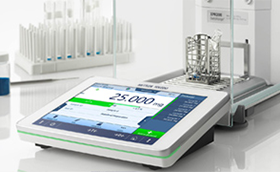
1. Prepare Calibration Standard Solution
1.1 Prepare Stock Standard Solution
Individual stock standard solutions typically are prepared to a concentration of 1 mg/mL. The required amount of pure pesticide reference standard (typically 10 – 50 mg) should be weighed out using a 4- or 5-decimal place balance or scale, depending on the method. Transfer to an appropriate volumetric flask, dissolve in a suitable solvent, and make up to the required volume to achieve the desired concentration. Label the flask with all relevant information. Liquid reference standards can be dispensed, by weight, directly into the solvent. It is also possible to purchase ready-made stock standard solutions of pesticide reference standards, if they are certified by the manufacturer or by an independent source.
1.2 Prepare Intermediate / Working Standard Solution
Working standard solutions typically have very low concentrations, in the range of 0.005 – 0.01 µg/mL. To achieve such low concentrations, it may be necessary to create intermediate solutions and dilute further to achieve the required concentration. For a multi-residue method, several pesticide standards are mixed. Combine appropriate quantities of the individual stock standard solutions to create the concentrations required for comparison against the sample under investigation.
2. Prepare an Extract of the Sample
Preparation of samples for pesticide residue analysis is a complex procedure and is dependent upon the sample type, the pesticides under investigation and risk of cross-contamination. In a complex sample matrix, it is necessary to remove unwanted interferences in order to focus on the pesticide content. Common extraction preparation techniques for pesticide residue analysis are QuEChERS (Quick, Easy, Cheap, Effective, Rugged and Safe) and Accelerated Solvent Extraction (ASE).
3. Measurement by GC-MS / LC-MS
Samples are typically analyzed using gas chromatography (GC) or high performance liquid chromatography (HPLC) in conjunction with mass spectrometry (MS) for identification and quantification of the pesticides present. The extracted samples are introduced into the analyzer in accordance with the manufacturer's instructions.
4. Data Evaluation and Storage
The results from the sample are compared to those from the working standard solution to identify and quantify the pesticides in the sample. This is typically done automatically by the analyzer, delivering results in mg/kg. To comply with pesticide limit regulations, the amount of each residue must not exceed the respective MRL of the target market. Results must be documented fully to ensure traceability.
















